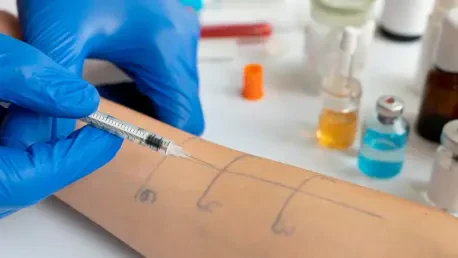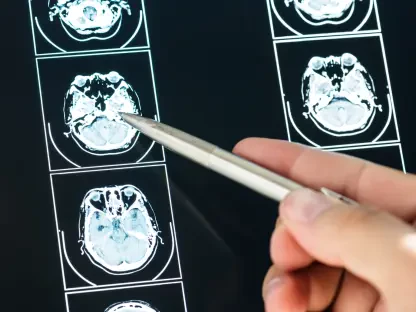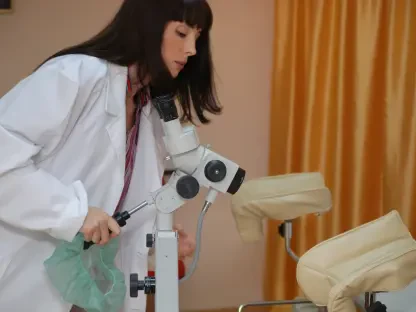The allergy diagnostics market has experienced steady growth in recent years, driven by a rising global incidence of allergy cases. Projections for the next decade and beyond indicate further expansion, with the market potentially surpassing $13 billion by 2035. This growth is attributed to increased public awareness, advancements in diagnostic technologies, and higher healthcare expenditures, making allergy diagnostics an increasingly vital segment of the medical industry.
Market Valuation and Anticipated Growth
As of 2024, the allergy diagnostics market was valued at approximately $5.99 billion. Over the next decade, it is projected to expand at a compound annual growth rate (CAGR) of 7.66%, potentially reaching a valuation of $13.48 billion by 2035. Several factors contribute to this optimistic forecast, including heightened awareness of allergic conditions among both patients and healthcare providers, as well as significant technological advancements that improve the accuracy and accessibility of diagnostic tests. Additionally, increased healthcare spending globally facilitates greater investment in allergy diagnostics, enabling broader access to these essential services.
The robust growth rate underscores the importance of allergy diagnostics in modern healthcare. As environmental changes and dietary habits continue to influence the prevalence of allergies, there is a correspondingly greater need for reliable diagnostic methods. This trend is evident across various demographics and regions, signifying a universal demand that spans both developed and developing countries. Consequently, the allergy diagnostics market is expected to maintain its upward trajectory, driven by continuous improvements in test quality and availability.
In-Depth Look at Allergy Diagnostics
Allergy diagnostics encompass a diverse array of tests designed to identify specific allergens and understand allergy-related antibodies or proteins. These tests are crucial for accurately diagnosing and effectively managing allergies. Among the most commonly used methods are skin prick tests, blood tests, and patch tests. Skin prick tests involve exposing the skin to small amounts of different allergens and observing reactions, while blood tests measure specific antibodies in the bloodstream that indicate allergic responses. Patch tests focus on diagnosing contact allergies by applying patches with allergens to the skin.
Each method offers distinct advantages and levels of accuracy. Skin prick tests are valued for their rapid results and high sensitivity, while blood tests provide a comprehensive assessment of allergic responses without the risk of skin reactions. Patch tests, on the other hand, are particularly effective for identifying allergens that cause delayed reactions, such as those from contact dermatitis. Collectively, these diagnostic tools form a vital part of allergy management, enabling targeted treatments and preventive measures.
Technological Advancements in Diagnostics
Technological advancements have played a pivotal role in enhancing the field of allergy diagnostics. Innovations have led to the development of rapid, easy-to-use, and highly accurate diagnostic tests, increasing their accessibility and reliability. These advancements are particularly significant in both developed and developing regions, where the demand for enhanced diagnostic capabilities and improved patient outcomes is steadily rising.
One notable development is the introduction of multiplex testing, which allows for the simultaneous detection of multiple allergens from a single sample. This innovation not only streamlines the diagnostic process but also provides a more comprehensive understanding of a patient’s allergic profile. Additionally, advancements in molecular diagnostics have facilitated the identification of specific allergen components, leading to more precise and targeted treatments. These technological improvements are critical in addressing the growing prevalence of allergies and enhancing overall patient care.
Driving Forces Behind Market Growth
Several key drivers are propelling the allergy diagnostics market forward. The increasing prevalence of allergies, often linked to environmental changes and dietary habits, is a primary factor. As more individuals suffer from allergies, the demand for accurate and reliable diagnostic methods grows correspondingly. Additionally, rising healthcare spending globally supports the expansion of allergy diagnostics, providing the necessary resources for research, development, and broader implementation of diagnostic services.
Public awareness about allergy symptoms and available treatments has also grown significantly, contributing to the market’s expansion. As individuals become more informed about their health, they are more likely to seek diagnostic services and take proactive measures to manage their allergies. Furthermore, government initiatives aimed at improving access to allergy diagnostics play a pivotal role in supporting market growth. These initiatives often include funding for research and development, public awareness campaigns, and policies that facilitate access to diagnostic services.
Addressing Challenges in the Market
Despite the optimistic outlook, the allergy diagnostics market faces several notable challenges. High testing costs can limit accessibility, particularly for economically disadvantaged populations. This issue underscores the need for more affordable and widely accessible diagnostic options. Additionally, inadequate awareness about allergies and their management results in under-diagnosis and non-treatment, further complicating the market landscape.
The continuous emergence of new allergens presents another significant challenge. As environmental factors evolve and new allergens develop, diagnostic methods must adapt to keep pace. This dynamic nature of allergens necessitates ongoing research and innovation within the allergy diagnostics field. Addressing these challenges requires a multifaceted approach involving government support, public education, and the development of cost-effective diagnostic solutions.
Opportunities Abound
The allergy diagnostics market is ripe with opportunities for growth and innovation. The increasing prevalence of allergies opens up new markets for diagnostics, particularly in regions with rising allergy cases and improving healthcare infrastructures. This trend is expected to drive substantial market expansion, as more individuals seek diagnostic and treatment options.
There is also significant potential for developing innovative, more accurate, and affordable testing methods. Technological advancements continue to pave the way for new diagnostic solutions that offer improved accuracy and convenience. Enhanced public awareness about allergies and their impact on health will likely drive more individuals to seek diagnostic services, further boosting market growth.
Segment-Specific Growth: Consumables and Diagnostic Labs
The consumables segment, which includes test kits, lancets, and swabs, is set for remarkable growth, driven by the urgent need for diagnostic tests. As allergy cases continue to rise, the demand for consumables used in diagnostic procedures increases accordingly. This segment is expected to benefit from continuous advancements in diagnostic technologies and the growing focus on early and accurate diagnosis.
Diagnostic laboratories are also experiencing significant expansion due to heightened disease awareness, availability of funds, and the need for professional diagnostics. These laboratories play a crucial role in providing accurate and reliable diagnostic services, essential for effective allergy management. The growth of diagnostic laboratories is further supported by increasing investments in healthcare infrastructure and technological advancements that enhance diagnostic capabilities.
Regional Market Dynamics
The allergy diagnostics market exhibits varying trends across different regions, reflecting each area’s unique healthcare landscape and prevalence of allergies. North America holds the largest market share, driven by advanced healthcare infrastructure, high allergy prevalence, and supportive reimbursement policies. The region benefits from significant investments in healthcare and technology, facilitating the widespread adoption of advanced diagnostic methods.
Europe follows closely as the second-largest market, benefiting from heightened awareness about allergies and favorable government policies that support access to diagnostic services. The region’s robust healthcare infrastructure and ongoing public health initiatives contribute to the market’s growth. The Asia-Pacific region is the fastest growing, with a robust CAGR fueled by increasing allergy cases, improving healthcare infrastructure, and growing public awareness. Latin America and the Middle East & Africa, though smaller markets, are expected to grow rapidly due to rising allergy cases and healthcare improvements in these regions.
Key Players Shaping the Market
Prominent players are instrumental in driving the allergy diagnostics market forward. Companies such as Thermo Fisher Scientific Inc., Siemens Healthineers, and Danaher are at the forefront of innovation, continually developing and expanding their product offerings. Other key participants, including Omega Diagnostics Group PLC, bioMérieux SA, and NEOGEN Corporation, contribute to the market’s dynamic growth through their extensive research and development efforts.
These companies are focused on enhancing diagnostic accuracy, accessibility, and affordability. Their contributions are vital in addressing the growing demand for reliable allergy diagnostics and in overcoming market challenges. The competitive landscape within the allergy diagnostics market encourages continuous innovation and improvement, ensuring that diagnostic methods evolve to meet the needs of patients and healthcare providers.
Diverse Market Segmentation
The market’s segmentation spans various product types, test types, allergen types, and end users, catering to differing market needs and enhancing overall growth potential. Product types include consumables, instruments, and services, each playing a critical role in the diagnostic process. Consumables encompass items like test kits, lancets, and swabs, which are essential for conducting diagnostic procedures. Instruments include devices used in skin prick tests and blood test analyzers, while services refer to diagnostic testing provided by healthcare professionals.
Test types are divided into in vivo (on-body tests) and in vitro (laboratory tests on blood or tissue samples). In vivo tests include skin prick tests and patch tests, while in vitro tests focus on analyzing samples for specific antibodies or proteins. Allergen types are categorized into inhalant allergens (such as pollen, dust mites, and pet dander), food allergens (including peanuts, eggs, and shellfish), drug allergens, and other allergens like insect venom and latex. End users range from hospitals and clinics to diagnostic laboratories, with hospitals being the largest segment due to their comprehensive diagnostic capabilities and access to advanced technology.
Strategic Recommendations for Growth
The allergy diagnostics market has been on a consistent upward trajectory in recent years, largely fueled by the growing global prevalence of allergies. According to projections, the market is set to experience considerable expansion over the next decade and beyond, potentially exceeding $13 billion by 2035. This anticipated growth can be attributed to several key factors.
First, public awareness about allergies and their impact on health has significantly increased. People are more cognizant of the need for accurate diagnostics to manage and mitigate allergic reactions effectively.
Secondly, advancements in diagnostic technologies have played a pivotal role in the market’s expansion. Innovations such as high-throughput screening methods, improved assays, and the development of personalized medicine have enhanced diagnostic accuracy and accessibility, making it easier for healthcare providers to diagnose and treat allergies.
Additionally, rising healthcare expenditures contribute to the growth of the allergy diagnostics market. Increased investment in healthcare infrastructure and services means that more resources are available for allergy testing and management, improving patient outcomes overall.
All these factors together make allergy diagnostics an increasingly important aspect of the medical industry. As awareness continues to grow and technology keeps advancing, the market is poised for substantial growth in the coming years.









